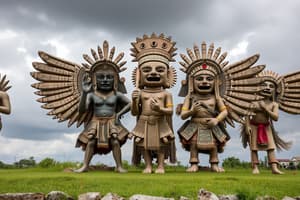Podcast
Questions and Answers
What duality is highlighted in Aztec society according to the content?
What duality is highlighted in Aztec society according to the content?
- Violence coexisting with creativity
- Brutality coexisting with refinement (correct)
- Justice coexisting with lawlessness
- Tradition coexisting with innovation
Which practice is notably associated with Aztec society?
Which practice is notably associated with Aztec society?
- Agricultural development
- Blood sacrifice (correct)
- Artistic expression
- Trade and commerce
What aspect of Aztec culture is mentioned as demanding blood sacrifice?
What aspect of Aztec culture is mentioned as demanding blood sacrifice?
- Their warrior traditions
- Their cosmology (correct)
- Their agricultural practices
- Their political policies
What is implied about the nature of violence in Aztec society?
What is implied about the nature of violence in Aztec society?
What can be inferred about the perception of Aztec society's complexity?
What can be inferred about the perception of Aztec society's complexity?
Flashcards
Aztec Society
Aztec Society
A complex society where aspects like war, bloodshed and justice existed simultaneously.
Aztec Cosmology
Aztec Cosmology
The Aztec worldview demanded blood sacrifice as a way to appease the gods.
Contradictions in Aztec Society
Contradictions in Aztec Society
Aztec society embraced both brutality in war and refinement in art and culture.
Violence and Justice in Aztec Society
Violence and Justice in Aztec Society
Signup and view all the flashcards
Refinement amidst Brutality
Refinement amidst Brutality
Signup and view all the flashcards
Study Notes
Aztec Society and Culture
-
Aztec society was characterized by a complex relationship between violence and artistic development.
- This involved a commitment to war and blood sacrifice, alongside complex codes of conduct, and achievements in art and administration.
-
Aztec Religion incorporated long-standing Mesoamerican religious aspects alongside political considerations.
- The Aztec rationale for human sacrifice was connected to their cosmology.
- They believed that the sun and earth had been destroyed and recreated four times, and believed that the current, fifth sun, was threatened with destruction, needing sustenance.
- The Aztecs saw human sacrifice as a vital means of sustaining the sun and the natural cycle.
- Gifts of life, including captured warriors, women, children, and slaves, were regarded as the most valuable contributions to the sun god.
- The removal of a palpitating human heart was the most profound expression of piety.
- Human sacrifice was not unique to the Aztecs but was part of other ancient cultures.
-
Human sacrifice served a purpose of cosmic renewal and nourishment for the gods.
-
The Aztecs feared that the sun might not rise, requiring the need for sacrificial blood to ensure militant expansionism.
-
Sacrifice was a religious ceremony for maintaining balance in the cosmic order.
-
Sacrifice maintained renewal and order within the cosmos.
-
Aztec society was not a simple social structure; in the initial stages, it involved a majority of peasants and warriors, with a limited number of priests and war leaders.
-
Following the settlement of Tenochtitlan, a complex class system emerged, including warriors, religious figures, and traders (pochteca).
-
The royal family held the highest status but were not absolute rulers.
- Rulers were generally chosen from royal families.
-
Noble women played important roles in forging alliances and strengthening royal legitimacy, though their leadership roles diminished as the empire developed.
-
Aztec society encompassed a complex class system, including nobles and commoners, and the lower class of slaves.
-
Slaves had certain rights and bondage wasn't always hereditary.
- Slaves served in various capacities, and slaves could intermarry with freeholders.
- Slaves were occasionally captured through warfare and were sometimes destined for sacrifice.
-
The Aztecs had a complex political organization that rested on tributary towns.
-
Aztec political authority was expressed through tribute and local autonomy.
-
The Aztec empire had different levels of authority but depended on tributary towns for support.
- The empire wasn't unified in terms of language, customs, or beliefs.
Aztec Art, Music, and Literature
- Aztec art borrowed elements from other Mesoamerican civilizations.
- They engaged in impressive stone sculpture, ceramics, and mosaics.
- Aztec music was primarily ceremonial and accompanied by dancing; musical instruments were vital for rituals.
- Poetry and song were connected to the gods and accompanied religious ceremonies.
- Aztec artistry was important for both practical and aesthetic purposes within society and was a manifestation of their understanding of the divine.
The City of Tenochtitlan
- Tenochtitlan, the Aztec capital, was a large and complex city.
- It contained numerous canals and causeways
- It was built on an island in Lake Texcoco
- It had a great center (Temple Mayor) with the royal palaces and other major structures.
- Tenochtitlan was meticulously designed and managed with respect to drainage and sanitation.
Studying That Suits You
Use AI to generate personalized quizzes and flashcards to suit your learning preferences.



